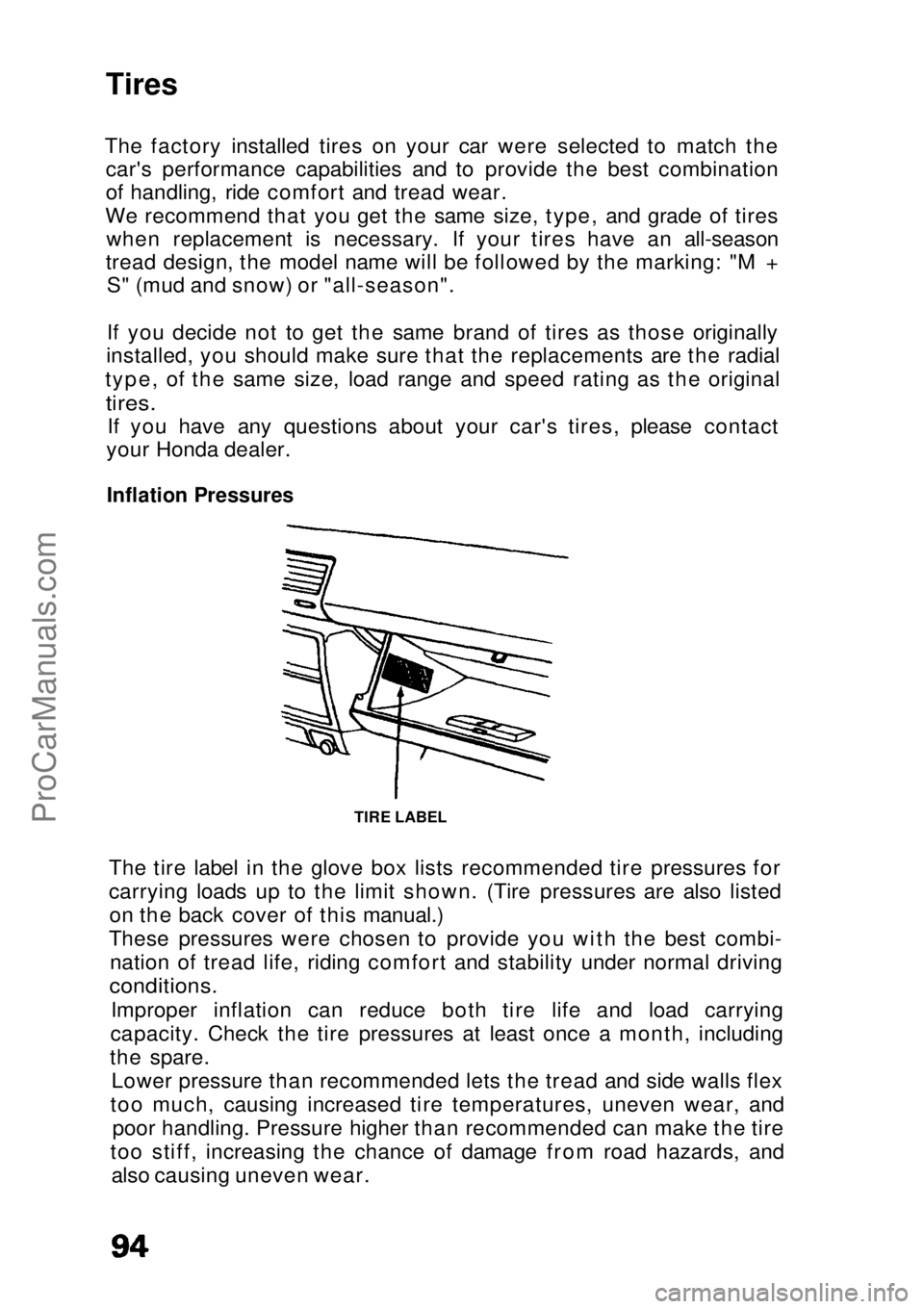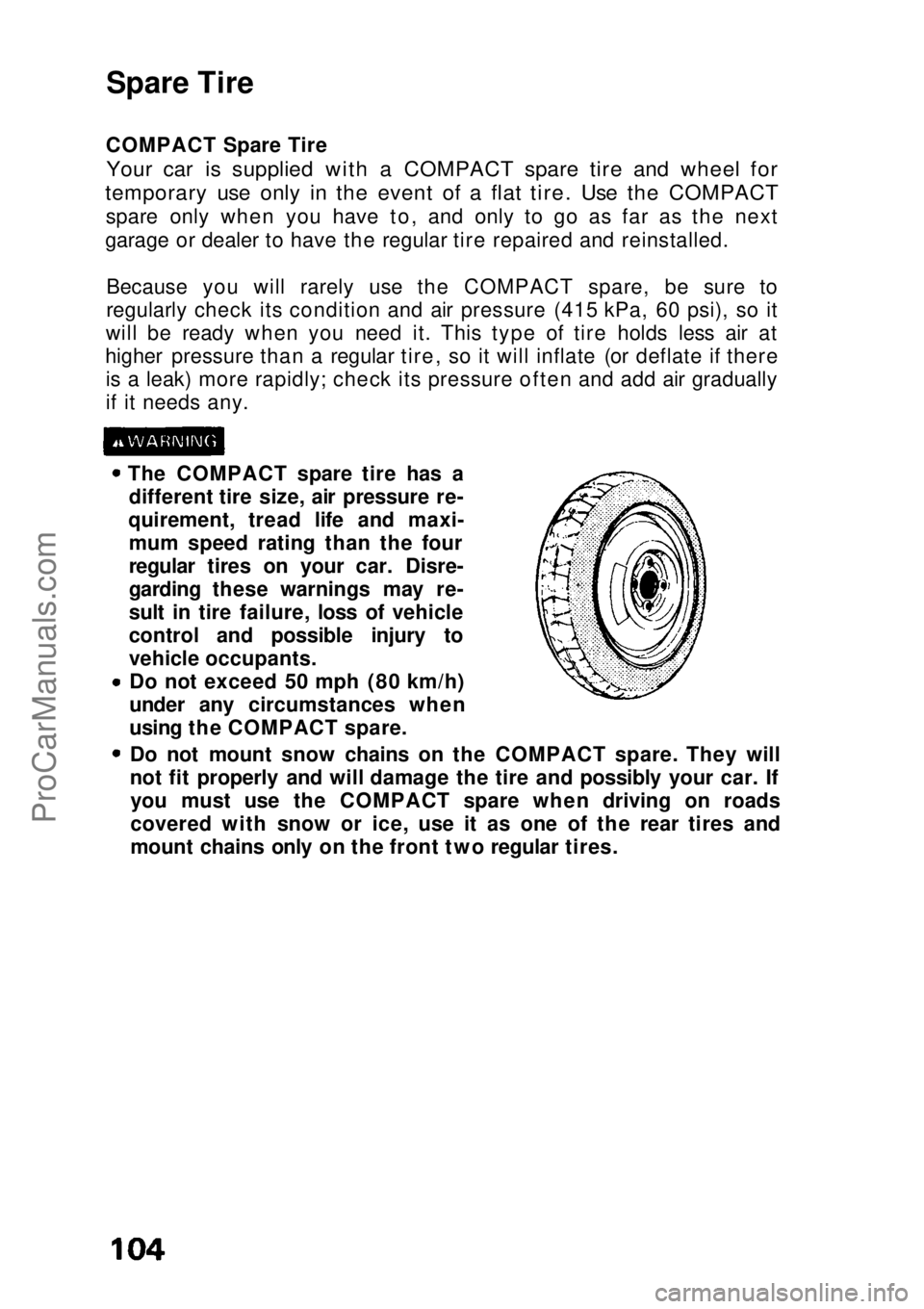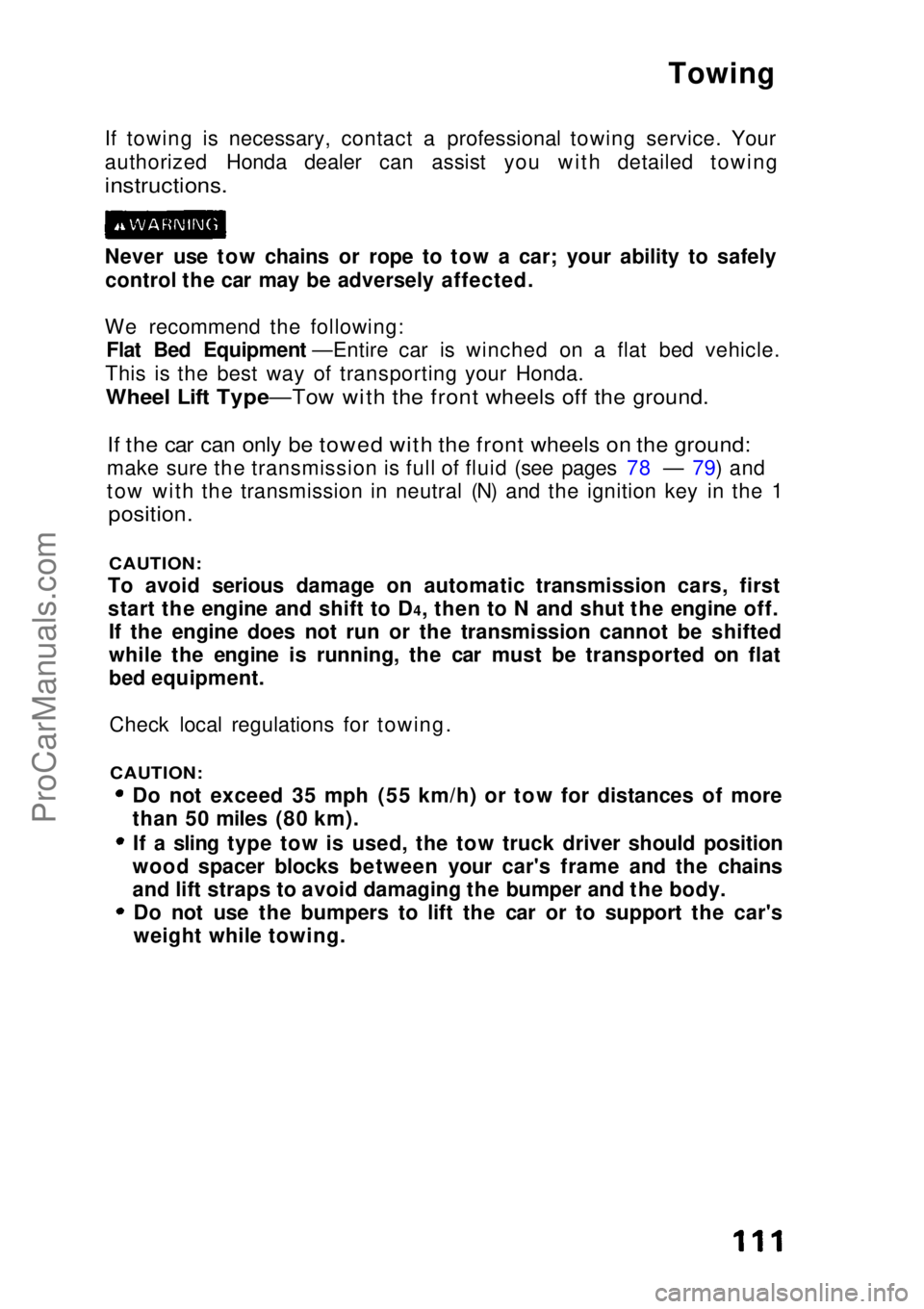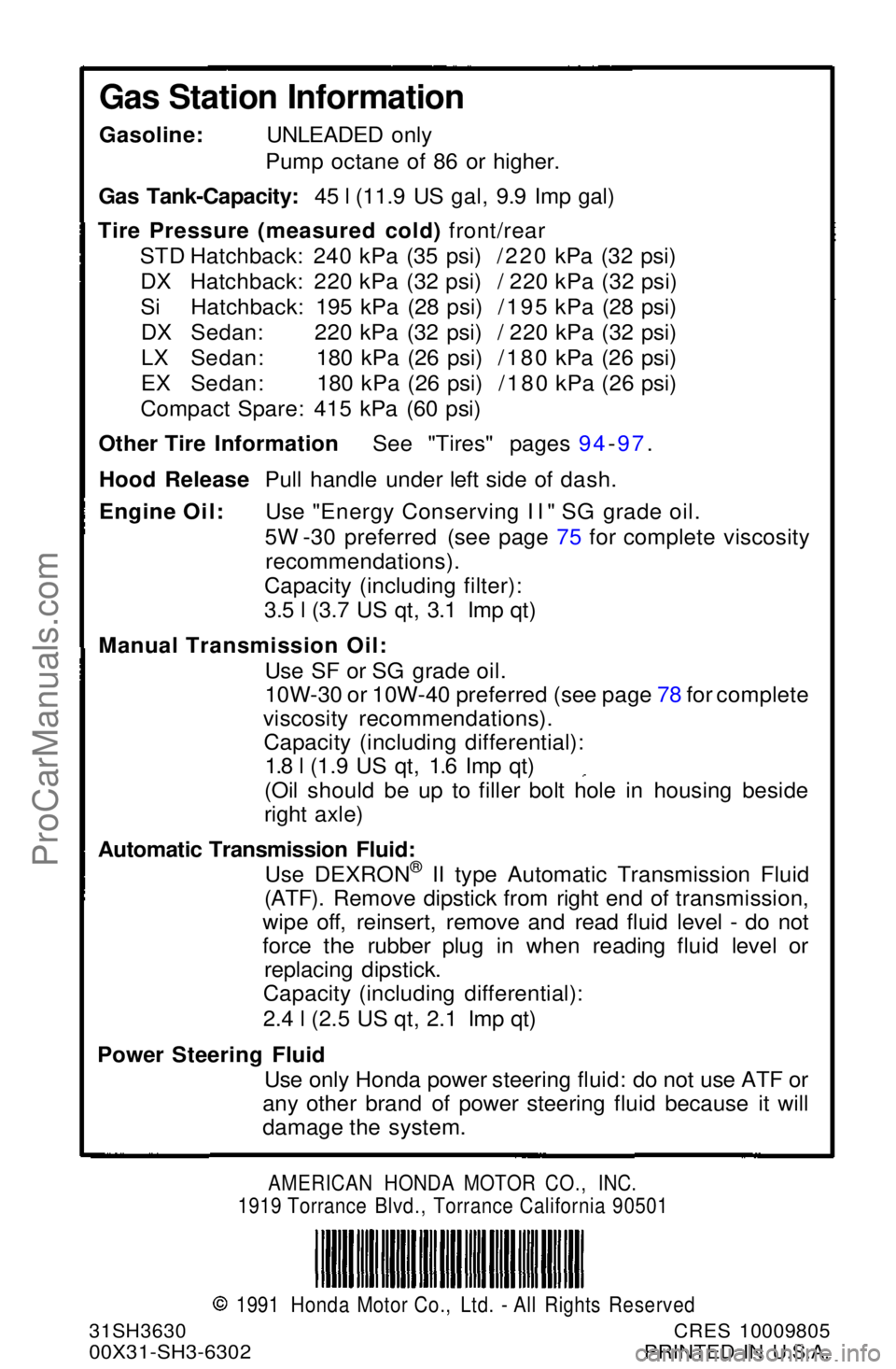tire type HONDA CIVIC 1991 Owners Manual
[x] Cancel search | Manufacturer: HONDA, Model Year: 1991, Model line: CIVIC, Model: HONDA CIVIC 1991Pages: 136, PDF Size: 1.33 MB
Page 94 of 136

The factory installed tires on your car were selected to match the
car's performance capabilities and to provide the best combination
of handling, ride comfort and tread wear.
We recommend that you get the same size, type, and grade of tires when replacement is necessary. If your tires have an all-season
tread design, the model name will be followed by the marking: "M + S" (mud and snow) or "all-season".
If you decide not to get the same brand of tires as those originally
installed, you should make sure that the replacements are the radial
type, of the same size, load range and speed rating as the original
tires.
If you have any questions about your car's tires, please contact
your Honda dealer.
Inflation Pressures
The tire label in the glove box lists recommended tire pressures for
carrying loads up to the limit shown. (Tire pressures are also listedon the back cover of this manual.)
These pressures were chosen to provide you with the best combi- nation of tread life, riding comfort and stability under normal driving
conditions.
Improper inflation can reduce both tire life and load carrying
capacity. Check the tire pressures at least once a month, including
the spare. Lower pressure than recommended lets the tread and side walls flex
too much, causing increased tire temperatures, uneven wear, and poor handling. Pressure higher than recommended can make the tire
too stiff, increasing the chance of damage from road hazards, and also causing uneven wear.
Tires
TIRE LABELProCarManuals.comMain Menu s t
Page 95 of 136

CAUTION:
Check tire pressure when the tires are cold.(After the car has been parked for more than 3 hours or driven
less than 1 mile/1.6 km.)
Tire pressure may increase as much as 41 kPa (6 psi) when the
tire is hot, so NEVER ADJUST tire pressure when the tires are hot.
Never inflate load range B tires to more than 220 kPa (32 psi)
cold.
Cars with luggage racks or cartop carriers DO NOT have greater
load limits than those on the label.
Winter Driving Tires marked "M + S" or "all season" have an all-weather treaddesign and should be suitable for most driving conditions. However,
snow tires and tire chains may be required under some conditions. Ifyour tires do not have these markings, they may not be suitable forwinter driving conditions. We recommend snow tires or tire chainsfor snow and icy conditions.
Snow TiresIf you use snow tires, they should be of the same size, construction
and load capacity as the original tires on your car. Snow tires must
be installed in sets of four, or they may cause poor handling. Driving
with snow tires on dry roads can reduce your car's performance
during acceleration, turning and stopping.
If you need further information on snow tires, please contact your
Honda dealer.
Tire Chains
Use chains only when you have to. Check with local authorities or
Provinces for requirements prior to installing tire chains. Make sure
the chains are the right size for your tires. Install them only on the
drive wheels of your car, and do so as tightly as possible, following
the manufacturer's instructions. If metal chains are used, they must
be SAE Class "S." Cable type traction devices can also be used.
Drive slowly with chains installed. If you hear the chains contacting
your car's body or chassis, stop and tighten them.
(cont'd)ProCarManuals.comMain Menu s t
Page 104 of 136

Spare Tire
COMPACT Spare Tire
Your car is supplied with a COMPACT spare tire and wheel for
temporary use only in the event of a flat tire. Use the COMPACT
spare only when you have to, and only to go as far as the next
garage or dealer to have the regular tire repaired and reinstalled.
Because you will rarely use the COMPACT spare, be sure to
regularly check its condition and air pressure (415 kPa, 60 psi), so it
will be ready when you need it. This type of tire holds less air at
higher pressure than a regular tire, so it will inflate (or deflate if there is a leak) more rapidly; check its pressure often and add air gradually
if it needs any.
The COMPACT spare tire has adifferent tire size, air pressure re-
quirement, tread life and maxi- mum speed rating than the four
regular tires on your car. Disre-
garding these warnings may re-
sult in tire failure, loss of vehicle
control and possible injury to
vehicle occupants.Do not exceed 50 mph (80 km/h)
under any circumstances when
using the COMPACT spare.
Do not mount snow chains on the COMPACT spare. They will
not fit properly and will damage the tire and possibly your car. Ifyou must use the COMPACT spare when driving on roads
covered with snow or ice, use it as one of the rear tires and
mount chains only on the front two regular tires.ProCarManuals.comMain Menu s t
Page 111 of 136

If towing is necessary, contact a professional towing service. Your
authorized Honda dealer can assist you with detailed towing
instructions.
Never use tow chains or rope to tow a car; your ability to safely
control the car may be adversely affected.
We recommend the following: Flat Bed Equipment —Entire car is winched on a flat bed vehicle.
This is the best way of transporting your Honda.
Wheel Lift Type—Tow with the front wheels off the ground.
If the car can only be towed with the front wheels on the ground:
make sure the transmission is full of fluid (see pages 78 — 79) and
tow with the transmission in neutral (N) and the ignition key in the 1
position.
CAUTION:
To avoid serious damage on automatic transmission cars, first
start the engine and shift to D4, then to N and shut the engine off. If the engine does not run or the transmission cannot be shifted
while the engine is running, the car must be transported on flat
bed equipment.
Check local regulations for towing.
CAUTION:
Do not exceed 35 mph (55 km/h) or tow for distances of more
than 50 miles (80 km).
If a sling type tow is used, the tow truck driver should position
wood spacer blocks between your car's frame and the chains
and lift straps to avoid damaging the bumper and the body. Do not use the bumpers to lift the car or to support the car's
weight while towing. TowingProCarManuals.comMain Menu s t
Page 136 of 136

AMERICAN HONDA MOTOR CO., INC.
1919 Torrance Blvd., Torrance California 90501 1991 Honda Motor Co., Ltd. - All Rights Reserved
31SH3630 CRES 10009805
00X31-SH3-6302 PRINTED IN U.S.A.
Gas Station Information
Gasoline: UNLEADED only
Pump octane of 86 or higher.
Gas Tank-Capacity: 45 l (11.9 US gal, 9.9 Imp gal)
Tire Pressure (measured cold) front/rear STD Hatchback: 240 kPa (35 psi) /220 kPa (32 psi)DX Hatchback: 220 kPa (32 psi) / 220 kPa (32 psi)
Si Hatchback: 195 kPa (28 psi) /195 kPa (28 psi)DX Sedan: 220 kPa (32 psi) / 220 kPa (32 psi)
LX Sedan: 180 kPa (26 psi) /180 kPa (26 psi)
EX Sedan: 180 kPa (26 psi) /180 kPa (26 psi)
Compact Spare: 415 kPa (60 psi)
Other Tire Information See "Tires" pages 94-97.
Hood Release Pull handle under left side of dash.
Engine Oil: Use "Energy Conserving II" SG grade oil. 5W -30 preferred (see page 75 for complete viscosityrecommendations).
Capacity (including filter):
3.5 l (3.7 US qt, 3.1 Imp qt)
Manual Transmission Oil: Use SF or SG grade oil.
10W-30 or 10W-40 preferred (see page 78 for complete
viscosity recommendations). Capacity (including differential): 1.8 l (1.9 US qt, 1.6 Imp qt)
(Oil should be up to filler bolt hole in housing beside
right axle)
Automatic Transmission Fluid:
Us
e
DEXRON® II type Automatic Transmission Fluid
(ATF). Remove
dipstick from right end of transmission,
wipe off, reinsert, remove and read fluid level - do not
force the rubber plug in when reading fluid level or replacing dipstick.
Capacity (including differential):
2.4 l (2.5 US qt, 2.1 Imp qt)
Power Steering Fluid Use only Honda power steering fluid: do not use ATF or
any other brand of power steering fluid because it will
damage the system.ProCarManuals.comMain Menu s t